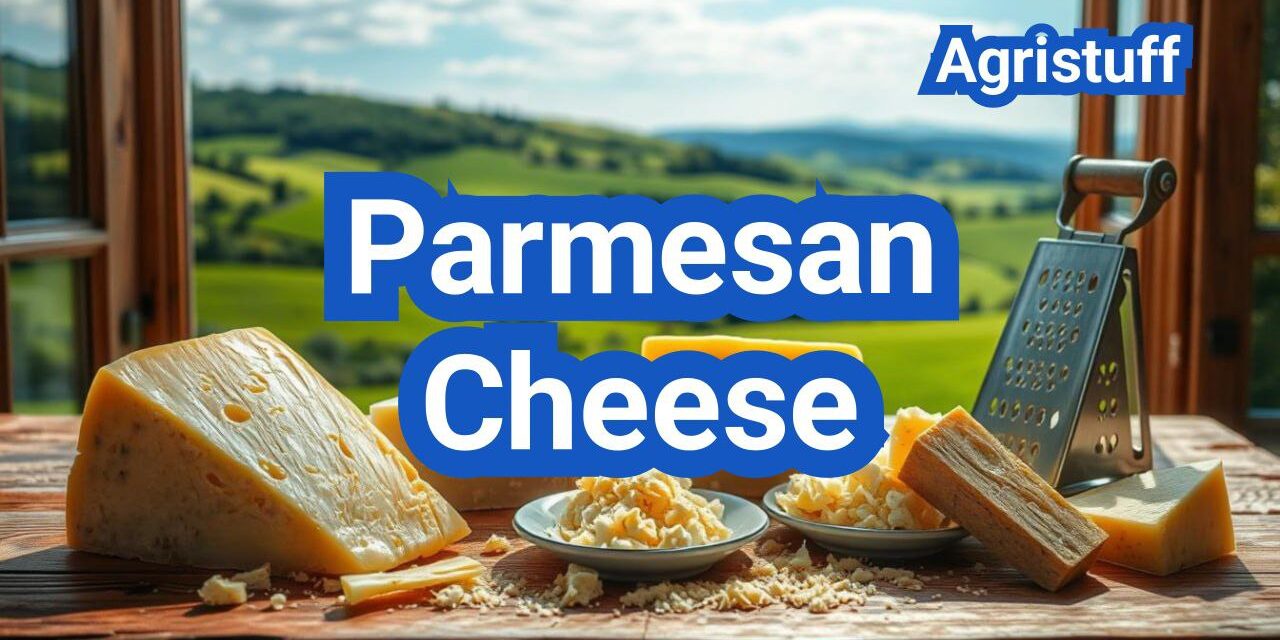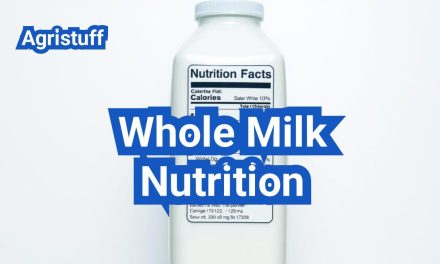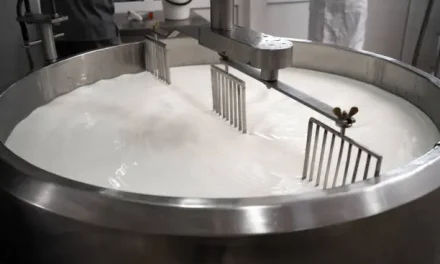Parmigiano Reggiano, commonly known as Parmesan , is a hard, granular cheese ( Hard cheese ) produced from cow’s milk. Aged for at least 12 months, it is renowned for its rich flavor and versatility in culinary applications.
This type of cheese has a long history dating back to the Middle Ages in Italy, where it originated. It is a grana-type cheese, similar to Grana Padano. The production process involves careful curdling, shaping, and aging, which contributes to its distinctive texture and taste.
The uses of Parmesan are diverse, ranging from grating over pasta dishes to being served as a table cheese. Its rich history, varied types, and intricate processing steps make it a fascinating subject for cheese enthusiasts and culinary professionals alike.
Key Takeaways
- Parmigiano Reggiano is a hard, granular cheese aged for at least 12 months.
- It is produced from cow’s milk and known for its rich flavor.
- The cheese has a long history originating in Italy.
- Its production involves careful curdling, shaping, and aging.
- Parmesan is versatile in its uses, from grating to being served as a table cheese.
The Rich Heritage of Parmesan Cheese
In the rolling hills of Northern Italy, a legendary cheese was born: Parmesan, a name synonymous with quality and tradition. Parmesan cheese, or more accurately Parmigiano Reggiano, has a rich history that spans centuries, deeply rooted in the regions of Parma and Reggio Emilia.
Origins in Northern Italy
The story of Parmesan cheese begins in the medieval period, where it was first produced by monks in the provinces of Parma and Reggio Emilia. Historical documents indicate that by the 13th and 14th centuries, Parmigiano Reggiano was already being made in a manner very similar to the production methods used today.
The unique conditions of Northern Italy, with its fertile plains and suitable climate, made it an ideal place for cheese production. The medieval history of this region is intertwined with the development of Parmesan cheese, which became a staple in the local cuisine.
Evolution Through the Centuries
Over the centuries, Parmesan cheese has evolved, yet its traditional production methods have remained largely unchanged. The cheese gained popularity across Europe, becoming a favorite among the nobility and clergy. Its durability and long shelf life made it an ideal product for trade and export.
Despite its widespread popularity, Parmigiano Reggiano remained closely associated with its place of origin. The cheese was often aged for several years, developing its characteristic granular texture and rich, nutty flavor. This aging process, combined with strict production standards, has contributed to the origins of Parmesan cheese being preserved and respected to this day.
What Makes Parmesan Cheese Special

What sets Parmesan cheese apart is its characteristic texture and the distinctive, savory flavor it develops through a meticulous aging process. This Italian cheese has become a staple in many cuisines around the world, thanks to its unique characteristics that make it versatile and highly prized.
Defining Characteristics
Parmesan cheese, known for its hard, granular texture, is a result of the careful processing and aging it undergoes. This texture is one of its defining characteristics, making it easily grateable and suitable for a variety of culinary applications. The granular texture is a result of the aging process, during which the cheese loses moisture and develops its characteristic crumbliness.
The production process of Parmesan cheese involves strict traditional methods, contributing to its distinctiveness. The cheese is made from cow’s milk, with the quality of the milk being paramount. The curdling process, cutting of the curds, and the subsequent aging are all crucial steps that influence the final product’s texture and flavor.
The Distinctive Flavor Profile
The flavor profile of Parmesan cheese is another aspect that makes it special. As it ages, Parmesan develops a nutty, savory flavor with a hint of saltiness. This flavor is a result of the breakdown of fats and proteins during the aging process, leading to the formation of compounds that contribute to its rich taste.
The aging process, which can range from 24 to 36 months or more, significantly impacts the flavor. The longer it ages, the more pronounced and complex the flavor becomes. This distinctive flavor profile makes Parmesan cheese a favorite among chefs and food enthusiasts, as it adds depth and umami flavor to dishes.
Understanding the characteristics and flavor profile of Parmesan cheese helps in appreciating its value in culinary applications. Whether grated over pasta, salads, or soups, or served as a table cheese, Parmesan’s unique attributes make it a cherished ingredient worldwide.
Authentic Parmigiano Reggiano vs. Generic Parmesan
Understanding the differences between authentic Parmigiano Reggiano and generic Parmesan requires a look into their production regulations and standards. While both cheeses share similarities, their distinct characteristics are shaped by their geographical origins and production processes.
PDO Protection and Regulations
Parmigiano Reggiano is a Protected Designation of Origin (PDO) cheese in the European Union, meaning it must be produced in specific regions of Italy, primarily in Parma and Reggio. This designation ensures that authentic Parmigiano Reggiano is made according to traditional methods and within a defined geographical area. The PDO status is a guarantee of quality and authenticity, as it adheres to strict production guidelines, including the use of raw cow’s milk, specific starter cultures, and a minimum aging period of 12 months, though typically aged for 24 or 36 months.
The production of Parmigiano Reggiano is overseen by the Consorzio del Formaggio Parmigiano-Reggiano, which enforces the PDO regulations. This includes rigorous inspections to ensure compliance with production standards, from milk collection to the aging process. The result is a cheese with a distinctive flavor profile and granular texture, characteristics that are highly prized by chefs and consumers alike.
FDA Standards for U.S. Parmesan
In contrast, “Parmesan” in the United States is not subject to the same PDO regulations as Parmigiano Reggiano in the EU. The FDA has standards for Parmesan cheese, defining it as a hard, granular cheese that may be made from cow’s milk, with or without added coloring. The FDA requires that it be aged for at least 10 months, though many U.S. producers age their Parmesan for longer periods to develop a sharper flavor.
While U.S. Parmesan can be of high quality, the lack of PDO status means that producers have more flexibility in their production methods, which can result in a wider variability in taste and texture compared to Parmigiano Reggiano. Consumers looking for authentic Parmesan should check labels for indications of aging time and production methods, as these can be indicators of quality.
When selecting Parmesan cheese, consumers should be aware of the differences between authentic Parmigiano Reggiano and generic Parmesan. Looking for the PDO label or checking the origin and production details can help ensure that you’re getting a high-quality cheese that meets your expectations.
Types of Parmesan Cheese Around the World

While Parmigiano Reggiano is the original, other types of Parmesan cheese have emerged globally, offering a range of flavors and textures. The diversity in production methods and aging processes has resulted in various types of Parmesan cheese enjoyed worldwide.
Italian Parmigiano Reggiano
Parmigiano Reggiano is the authentic Italian version of Parmesan cheese, produced exclusively in the provinces of Parma and Reggio Emilia. It is known for its granular texture and sharp, salty flavor. The production of Parmigiano Reggiano is strictly regulated, with a minimum aging period of 12 months, though many producers age it for 24 or 36 months for enhanced flavor.
U.S. Parmesan Varieties
In the United States, Parmesan cheese is produced with some variations in the traditional method. U.S. producers often use pasteurized milk and may age the cheese for different durations. Some notable U.S. varieties include:
- 12-Month Aged Parmesan: Younger and milder than its Italian counterpart.
- 24-Month Aged Parmesan: More intense in flavor, balancing sharpness and richness.
Other Similar Hard Cheeses
Beyond Parmigiano Reggiano and U.S. Parmesan, other countries produce similar hard cheeses that are often compared to Parmesan. These include:
| Cheese Type | Origin | Description |
|---|---|---|
| Grana Padano | Italy | Similar to Parmigiano Reggiano but with a slightly sweeter taste and less aging. |
| Sbrinz | Switzerland | A strong, hard cheese with a rich, nutty flavor. |
| Dutch Parmesan | Netherlands | Produced in the Netherlands, often with a milder flavor than Italian Parmigiano Reggiano. |
The variety of Parmesan cheese types around the world caters to different tastes and culinary uses, making Parmesan a versatile ingredient in global cuisine.
Step-by-Step Parmesan Cheese Production Process
The art of creating Parmesan cheese requires a meticulous step-by-step approach. This traditional Italian cheese is made through a process that involves careful milk selection, precise curd formation, and a lengthy aging period.
Step 1: Milk Selection and Preparation
The production of Parmesan cheese begins with the selection of high-quality milk. Fresh cow’s milk is used, often from local dairy farms. The milk is partially skimmed to achieve the desired fat content, which is crucial for the development of the cheese’s characteristic flavor and texture.
Step 2: Curd Formation and Cutting
The next step involves adding a natural starter culture and rennet to the milk to initiate curd formation. The curd is then cut into small granules to release whey and create a smooth, even texture. This process is critical in developing the cheese’s final consistency.
Step 3: Cooking and Draining
After cutting, the curd is cooked to a high temperature to remove excess whey and develop the cheese’s flavor. The cooking process involves heating the curd to around 55°C (131°F), making it firm and ready for the next stage.
Step 4: Molding and Initial Pressing
The cooked curd is then molded into its characteristic wheel shape. The cheese is wrapped in a cloth or plastic, and an initial pressing is applied to expel any remaining whey and to give the cheese its shape.
These steps form the foundation of the Parmesan cheese making process. Each stage, from milk selection to molding, plays a crucial role in developing the cheese’s distinctive flavor and texture.
Essential Equipment for Making Parmesan Cheese

Making authentic Parmesan cheese requires specific, high-quality equipment that has been used for centuries in the traditional production process. The right equipment is crucial for developing the characteristic flavor and texture of this iconic cheese.
Traditional Copper Vats and Containers
The use of traditional copper vats is a hallmark of Parmesan cheese production. Copper is an excellent conductor of heat, allowing for precise temperature control during the cheese-making process. According to cheesemaking experts, “Copper vats play a crucial role in creating the unique flavor profile of Parmesan cheese.”
“Copper vats are not just a tradition; they’re a necessity for producing high-quality Parmesan cheese,” says a renowned cheesemaker.
These vats are typically large and deep, allowing for the production of large wheels of cheese.
Specialized Cutting and Stirring Tools
The process of making Parmesan cheese involves cutting and stirring the curd to the right consistency. Specialized tools are used for this purpose, including long, flexible cutters and sturdy stirring rods. These tools are designed to reach the bottom of the deep copper vats, ensuring that the curd is evenly cut and stirred.
| Tool | Purpose |
|---|---|
| Long, flexible cutters | Cutting curd to desired size |
| Stirring rods | Evenly stirring curd |
Aging Shelves and Environment Control Systems
After the cheese is molded and pressed, it is transferred to aging shelves where it will mature for at least 12 months. These shelves are typically made of wood and are designed to allow for good air circulation around each wheel of cheese. The aging rooms are climate-controlled to maintain a consistent temperature and humidity level, which is crucial for developing the characteristic flavor and texture of Parmesan cheese.
Aging Environment Conditions:
- Temperature: between 55°F and 60°F
- Humidity: around 80%
- Air circulation: Regular turnover to prevent mold buildup
In conclusion, the production of Parmesan cheese relies on a combination of traditional equipment and modern climate control systems. From copper vats to aging shelves, each piece of equipment plays a vital role in creating the distinctive characteristics of this beloved cheese.
The Art of Aging Parmesan Cheese

Parmesan cheese aging is an art that requires patience and precision. The aging process significantly impacts the final product’s flavor and texture, making it a crucial step in Parmesan cheese production.
24-Month vs. 36-Month Aging Process
The aging period for Parmesan cheese can vary, with some varieties aged for 24 months and others for 36 months. The longer aging process is known to intensify the cheese’s flavor.
24-Month Aging: At 24 months, Parmesan cheese has a relatively milder flavor compared to its 36-month counterpart. It retains more moisture, resulting in a slightly softer texture.
36-Month Aging: Extending the aging process to 36 months allows for a more pronounced flavor development. The cheese becomes drier and more crumbly, with a more intense umami taste.
| Aging Period | Flavor Profile | Texture |
|---|---|---|
| 24 Months | Milder, less intense | Softer, more moist |
| 36 Months | More pronounced, intense umami | Drier, crumbly |
How Aging Affects Flavor and Texture
The aging process is critical in developing Parmesan cheese’s characteristic flavor and texture. As the cheese ages, enzymes break down the fats and proteins, resulting in a more complex flavor profile.
The texture also changes significantly over time. Younger Parmesan cheese tends to be more pliable, while older cheese becomes harder and more granular.
In conclusion, the art of aging Parmesan cheese is a delicate balance between time and quality. Whether aged for 24 or 36 months, the end result is a rich, complex cheese that enhances various culinary dishes.
Understanding Parmesan Cheese Crystals

Parmesan cheese crystals are a hallmark of aged cheese, contributing to its distinctive texture and flavor. These crystals are not just a natural occurrence; they are a sign of the cheese’s maturity and quality.
The formation of crystals in Parmesan cheese is primarily due to the concentration of certain compounds during the aging process. As the cheese ages, the moisture content decreases, and the concentration of salts and proteins increases.
Formation of Tyrosine Crystals
Tyrosine crystals are a type of crystal commonly found in aged Parmesan cheese. They form when the amino acid tyrosine, naturally present in the cheese, crystallizes due to the aging process. The crystallization of tyrosine is influenced by factors such as the aging temperature, humidity, and the cheese’s moisture content.
Factors Influencing Tyrosine Crystal Formation:
- Aging temperature
- Humidity levels
- Cheese moisture content
- Presence of tyrosine
Why Crystals Indicate Quality
The presence of tyrosine crystals in Parmesan cheese is often seen as an indicator of high-quality cheese. This is because the conditions required for crystal formation are quite specific, and not all cheeses meet these criteria.
| Characteristic | High-Quality Parmesan | Lower-Quality Parmesan |
|---|---|---|
| Crystal Presence | Abundant tyrosine crystals | Few or no crystals |
| Aging Process | Properly aged (24-36 months) | Under or over-aged |
| Texture and Flavor | Complex, crumbly texture; rich flavor | Less complex texture; milder flavor |
In conclusion, the crystals in Parmesan cheese, particularly tyrosine crystals, are not just a natural part of the aging process; they are indicators of the cheese’s quality and maturity. The presence of these crystals contributes to the cheese’s distinctive texture and flavor profile, making aged Parmesan a prized ingredient in many culinary applications.
Nutritional Profile of Parmesan Cheese
Parmesan cheese is renowned not only for its rich flavor but also for its impressive nutritional profile. As a nutrient-rich food, it provides a significant amount of protein, calcium, and various vitamins and minerals essential for maintaining good health.
Caloric Content and Macronutrients
Parmesan cheese is relatively high in calories, primarily due to its fat content. A 1-ounce serving (about 28 grams) of Parmesan cheese contains approximately 110 calories. The macronutrient breakdown includes around 7-8 grams of protein, 9 grams of fat (with a significant portion being saturated), and minimal carbohydrates.
The high protein content in Parmesan cheese makes it an excellent choice for those looking to increase their protein intake. However, the saturated fat content necessitates moderation in consumption, especially for individuals with heart health concerns.
Vitamins and Minerals
Parmesan cheese is a rich source of several vitamins and minerals. It is particularly high in calcium, phosphorus, and vitamin B12. A 1-ounce serving can provide about 33% of the recommended daily intake of calcium, which is crucial for bone health.
Other notable vitamins and minerals present in Parmesan cheese include:
- Vitamin A: Important for vision and immune function
- Riboflavin (B2): Essential for energy production and can help reduce the risk of certain health conditions
- Zinc: Plays a critical role in immune function and wound healing
Health Benefits and Considerations
The nutritional profile of Parmesan cheese translates into several health benefits when consumed in moderation. The high calcium content supports bone health, potentially reducing the risk of osteoporosis. The protein content can aid in muscle maintenance and satiety.
However, due to its high calorie and saturated fat content, Parmesan cheese should be consumed in moderation. Individuals with lactose intolerance or dairy allergies need to be cautious. Additionally, the high sodium content may be a concern for those with hypertension or other heart health issues.
| Nutrient | Amount per 1 oz (28g) | % Daily Value |
|---|---|---|
| Calories | 110 | 5% |
| Protein | 7-8g | 15% |
| Fat | 9g | 14% |
| Calcium | 330mg | 33% |
| Vitamin B12 | 1.4mcg | 23% |
In conclusion, Parmesan cheese can be a nutritious addition to a balanced diet when consumed in moderation. Its rich nutritional profile, including high protein and calcium content, offers several health benefits. However, it’s essential to be mindful of its high calorie and saturated fat content.
How to Select Authentic Parmesan Cheese

In a market flooded with various types of Parmesan, choosing the authentic product is an art that involves several factors. Authentic Parmesan cheese, known as Parmigiano Reggiano, is a staple in Italian cuisine, and its quality is paramount for culinary excellence.
Reading Labels and Certification Marks
The first step in selecting authentic Parmesan cheese is to read the labels carefully. Look for the Parmigiano Reggiano PDO label, which is a certification mark indicating that the product is made according to traditional methods and within a specific geographic area. This Protected Designation of Origin (PDO) status is a guarantee of the cheese’s authenticity and quality.
Certification marks are crucial because they ensure compliance with strict production regulations. When shopping, check for these marks on the packaging or rind of the cheese. The presence of these certifications is a strong indicator that you are purchasing authentic Parmesan cheese.
Visual and Tactile Indicators of Quality
Beyond labels, the appearance and texture of Parmesan cheese can provide valuable clues about its authenticity. Genuine Parmigiano Reggiano has a granular texture and a nutty, fruity flavor. The color should be a natural, golden yellow. Be wary of cheeses that are too white or have an unnatural color, as these may be indicators of artificial aging or coloring.
When possible, inspect the cheese visually and tactilely. A genuine block of Parmesan should have a slightly rough surface and a firm texture. The presence of tyrosine crystals, which appear as white specks, is a sign of proper aging and quality.
Price Considerations and Value
The price of Parmesan cheese can vary significantly based on factors like age, production methods, and origin. Authentic Parmigiano Reggiano is generally more expensive than generic Parmesan due to its strict production standards and aging process. Be cautious of very cheap options, as they may be compromises on quality or authenticity.
When evaluating the value, consider the aging process. A 24-month aged Parmesan will typically be less expensive than a 36-month aged one. The longer aging process contributes to a more complex flavor profile, justifying the higher cost. Ultimately, the price should reflect the quality and authenticity of the cheese.
Proper Storage Techniques for Parmesan Cheese
Storing Parmesan cheese properly is vital for extending its shelf life and maintaining its characteristics. Whether you’re dealing with a block, grated, or shredded Parmesan, the storage method can significantly impact its flavor and texture.
Short-term Storage Methods
For short-term storage, Parmesan cheese should be kept in a cool, dry environment. Wrap the cheese tightly in wax paper or plastic wrap to prevent moisture from entering and causing mold. Store it in the refrigerator at a consistent temperature below 40°F (4°C). This method is ideal for short-term use within a few weeks.
Long-term Preservation Strategies
For long-term preservation, consider freezing Parmesan cheese. Grate or shred the cheese before freezing to make it easier to use later. Place the grated cheese in an airtight container or freezer bag, ensuring to remove as much air as possible before sealing. Frozen Parmesan can last for several months without significant quality loss. When you’re ready to use it, simply thaw the needed amount in the refrigerator or at room temperature.
By following these storage techniques, you can enjoy your Parmesan cheese for a longer period while maintaining its distinctive flavor and texture.
Culinary Uses of Parmesan Cheese

The versatility of Parmesan cheese makes it a favorite among chefs worldwide. Its rich flavor and granular texture make it an ideal ingredient for a variety of dishes, from traditional Italian recipes to modern culinary innovations.
Traditional Italian Applications
Parmesan cheese is a staple in Italian cuisine, particularly in pasta dishes. It’s often grated over spaghetti carbonara or fettuccine Alfredo, adding a salty, nutty flavor. In addition to pasta, Parmesan is used in risottos, salads, and as a topping for soups.
“Parmesan is the king of cheeses, and its presence elevates any dish it’s added to.”
Italian Chef
Modern Culinary Innovations
Modern chefs have found innovative ways to incorporate Parmesan cheese into their recipes. It’s used in sauces, baked goods, and even as a crust for meats. The cheese’s umami flavor enhances the taste of various ingredients, making it a versatile component in contemporary cooking.
Using Grated, Shaved, and Block Forms
Parmesan cheese can be used in different forms, each suitable for specific applications. Grated Parmesan is ideal for sprinkling over pasta or salads, while shaved Parmesan adds a delicate touch to dishes. Block Parmesan can be served on its own or used in cooking.
| Form | Best Use |
|---|---|
| Grated | Pasta dishes, salads, soups |
| Shaved | Salads, antipasto platters, pasta |
| Block | Serving on cheese boards, grating fresh, cooking |
Parmesan Cheese Powder Applications
Parmesan cheese powder is a convenient alternative to fresh Parmesan. It’s used as a seasoning in various recipes, from soups to sauces. The powder form is particularly useful for achieving a consistent flavor throughout a dish.
Some popular uses for Parmesan cheese powder include:
- Seasoning for popcorn or roasted vegetables
- Ingredient in homemade spice blends
- Additive for soups and sauces
Creative Uses for Parmesan Cheese Rinds

The often-overlooked Parmesan cheese rind is a treasure trove of flavor waiting to be unleashed. Instead of discarding it, you can use it to enhance various dishes, reducing waste and adding depth to your culinary creations.
Flavor Enhancement in Soups and Broths
One of the most popular uses for Parmesan cheese rinds is to add them to soups and broths for an extra layer of flavor. Simply simmer the rind in your liquid of choice, then remove it before serving. This technique is particularly effective in minestrone, creamy broths, and risottos. The rind infuses a rich, umami flavor that elevates the overall taste of the dish.
Unexpected Applications for Rinds
Beyond soups and broths, Parmesan cheese rinds can be used in various creative ways. You can use them to make a flavorful stock by simmering the rinds in water, then straining and using the liquid as a base for other recipes. Some chefs even use Parmesan rinds to add depth to sauces, stews, and braising liquids. Experiment with grating the rind over dishes as a finishing touch, or blend it into a powder to use as a seasoning.
By incorporating Parmesan cheese rinds into your cooking, you not only reduce waste but also add a layer of complexity and richness to your dishes. Whether you’re making a hearty soup or a sophisticated sauce, the rind is a versatile ingredient that can enhance a wide range of culinary creations.
Parmesan Cheese vs. Grana Padano: Key Differences
The world of Italian cheese is rich with varieties, among which Parmesan and Grana Padano stand out for their unique characteristics. While both are hard, granular cheeses often used in similar contexts, they have distinct differences in production methods, flavor, and texture.
Production Variations
The production process of Parmesan, also known as Parmigiano Reggiano, is strictly regulated and involves a longer aging period, typically between 24 to 36 months. In contrast, Grana Padano has a shorter aging process, usually around 9 months, although it can be aged longer. This difference in aging contributes to variations in their flavor and texture.
Parmesan Cheese Production: Involves a more complex and longer process, including a curdling phase and a minimum aging period of 24 months.
Grana Padano Production: Has a relatively simpler process with a shorter aging period, making it ready for consumption sooner.
Flavor and Texture Comparison
The flavor profile of Parmesan is often described as more intense and nutty due to its longer aging process. Grana Padano, on the other hand, has a milder, creamier taste. The texture of both cheeses is granular, but Parmesan tends to be more crumbly.
- Parmesan: Intense, nutty flavor; crumbly texture.
- Grana Padano: Milder, creamier taste; granular texture.
Usage and Substitution Guidelines
While both cheeses can be used interchangeably in many recipes, the choice between them often depends on personal preference and the desired flavor intensity. For dishes requiring a stronger cheese flavor, Parmesan is preferable. For a milder taste, Grana Padano can be substituted.
In conclusion, understanding the differences between Parmesan and Grana Padano can enhance culinary experiences by allowing for more informed choices based on flavor preferences and recipe requirements.
Suitable Substitutes for Parmesan Cheese
The quest for the perfect Parmesan substitute has led to the discovery of various hard cheeses and plant-based options. Whether you’re looking for a similar flavor profile or a dairy-free alternative, there are several choices available.
Hard Cheese Alternatives
If you’re looking for a dairy-based substitute for Parmesan, several hard cheeses can fill the gap. Asiago, for instance, offers a nutty flavor that can complement dishes similarly to Parmesan. Grana Padano, another Italian cheese, is often considered a close relative of Parmesan due to its similar production process and flavor profile, although it’s typically milder.
Other hard cheeses like Pecorino Romano can be used as substitutes in certain recipes, especially those where a sharp, salty flavor is desired. It’s worth noting that these cheeses have distinct flavor profiles, so the choice of substitute may depend on the specific dish you’re preparing.
Plant-Based Parmesan Options
For those following a vegan diet or looking for dairy-free alternatives, plant-based Parmesan cheese substitutes have become increasingly popular. These are often made from nuts such as cashews or almonds, and nutritional yeast, which provides a cheesy, nutty flavor.
Some brands have developed vegan Parmesan cheese that closely mimics the taste and texture of traditional Parmesan. These products can be used in a variety of dishes, from pasta and salads to pizzas. As one chef noted, “Vegan Parmesan has opened up new possibilities for our menu, allowing us to cater to a wider range of dietary preferences without compromising on flavor.”
When using plant-based Parmesan substitutes, it’s essential to consider the flavor profile and texture they bring to your dish, as these can vary significantly between brands and ingredients used.
“The rise of vegan Parmesan has been a game-changer for chefs looking to innovate while respecting dietary restrictions.”
The Enduring Legacy of Parmesan Cheese
Parmesan cheese, often referred to as the “King of Cheeses,” has left an indelible mark on the culinary world. Its rich history, diverse types, and versatile applications have cemented its place in kitchens around the globe.
The significance of Parmesan cheese lies not only in its distinctive flavor profile but also in its cultural heritage. From traditional Italian recipes to modern culinary innovations, Parmesan cheese continues to be a beloved ingredient, enhancing dishes with its nutty, umami taste.
The parmesan cheese legacy is a testament to the craftsmanship and dedication of cheese makers who have perfected the art of producing this iconic cheese. As a staple in many cuisines, Parmesan cheese remains a symbol of quality and tradition, ensuring its continued relevance in the world of gastronomy.
Whether used as a grated topping, a shaved garnish, or a key ingredient in sauces, Parmesan cheese adds depth and complexity to a wide range of dishes, solidifying its position as a fundamental component of modern cooking.
FAQ
What is Parmesan cheese and what is special about it?
Parmesan cheese, also known as Parmigiano Reggiano, is a hard Italian cheese made from cow’s milk. It’s special due to its distinctive flavor profile, granular texture, and rich nutritional profile.
What is the difference between Parmesan and Parmigiano Reggiano?
Parmesan is a generic term, while Parmigiano Reggiano is a protected designation of origin (PDO) cheese produced in specific regions of Italy, adhering to traditional production methods and quality standards.
How is Parmesan cheese made?
Parmesan cheese is made through a multi-step process involving milk selection, curd formation, cooking, molding, and aging, with the cheese being aged for a minimum of 12 months, and often up to 36 months or more.
What are the health benefits of Parmesan cheese?
Parmesan cheese is rich in protein, calcium, and vitamins, making it a nutritious addition to a balanced diet. It also contains beneficial compounds like conjugated linoleic acid (CLA) and probiotics.
Is Parmesan cheese vegetarian?
Traditional Parmigiano Reggiano is not always vegetarian due to the use of animal rennet. However, some producers use microbial rennet, making their Parmesan cheese vegetarian-friendly.
How should I store Parmesan cheese?
To preserve its flavor and texture, store Parmesan cheese in an airtight container in the refrigerator, wrapped in plastic wrap or aluminum foil, and keep it away from strong-smelling foods.
Can I use Parmesan cheese rinds in cooking?
Yes, Parmesan cheese rinds can be used to add depth and umami flavor to soups, stews, and broths. Simply simmer the rind in the liquid and then discard it before serving.
What are some suitable substitutes for Parmesan cheese?
Hard cheeses like Grana Padano, Pecorino Romano, and Asiago can be used as substitutes for Parmesan. For vegan options, consider nutritional yeast or plant-based Parmesan alternatives.
How do I select authentic Parmesan cheese?
Look for the PDO certification mark, check the label for the producer’s name and address, and be wary of very low prices. Authentic Parmigiano Reggiano is typically sold in wedge form, with a granular texture and a rich, nutty flavor.
What is the difference between 24-month and 36-month aged Parmesan cheese?
The aging process affects the flavor and texture of Parmesan cheese. 24-month aged Parmesan is generally milder, while 36-month aged Parmesan is more complex and crumbly.
Can I grate Parmesan cheese ahead of time?
While it’s convenient to grate Parmesan cheese ahead of time, it’s best to grate it just before use to preserve its flavor and texture. Pre-grated Parmesan may contain additives to prevent clumping.
Is Parmesan cheese healthy?
Parmesan cheese can be part of a healthy diet when consumed in moderation. It’s rich in nutrients, but also high in calories and sodium.
Conclusion of: Parmesan Cheese
Parmesan Cheese at a Glance
Parmesan Cheese—globally beloved for its nutty, savory depth and “umami” punch—is a hard, granular grating cheese traditionally produced in Northern Italy and matured to achieve its crumbly texture and signature aroma. In culinary and agricultural contexts, Parmesan Cheese is a benchmark of craftsmanship: it’s made with just milk, rennet and salt, then aged under strict rules that protect quality and origin. — Consorzio Parmigiano Reggiano – How it’s made
What Do We Mean by “Parmesan Cheese”?
In the U.S., “Parmesan Cheese” is a legal standard of identity for a hard grating cheese with specific moisture and fat parameters; in Italy and the EU, the protected name is Parmigiano Reggiano (PDO), which follows stricter geographic and production rules. Understanding both terms helps U.S. shoppers compare products accurately while keeping the main focus on authentic quality. — 21 CFR §133.165 (Parmesan and reggiano cheese)
Parmesan Cheese and Protected Origin (PDO)
When people speak about authentic Parmesan Cheese in Europe, they usually mean Parmigiano Reggiano PDO, produced only within defined provinces in Emilia-Romagna and Lombardy. The PDO registry lists the recognized producer group and underscores the strict traceability that safeguards the cheese’s reputation. — EU eAmbrosia – Parmigiano Reggiano (PDO)
Parmesan Cheese: A Thousand Years of History
Parmesan Cheese traces its origins to medieval Benedictine and Cistercian monasteries that sought a long-keeping cheese made from local milk and salt. This continuity of place, people and practice is part of why Parmesan Cheese still tastes unmistakably “of” its region. — Consorzio – History
Ingredients & Milk Rules Behind Parmesan Cheese
Authentic Parmesan Cheese (Parmigiano Reggiano) uses only three ingredients—cow’s milk, salt, and calf rennet—and is checked wheel-by-wheel by the consortium. Feed rules emphasize local forage, and silage is forbidden in the Parmigiano Reggiano system to preserve quality and terroir expression. — Consorzio – Official Guidelines (PDF)
Parmesan Cheese: Cultures, Acidity, and Flavor Development
Starter cultures (often from the previous day’s whey) acidify the milk and set the stage for ripening—key to the savory complexity associated with well-matured Parmesan Cheese. These cultures drive both safety and flavor while shaping the cheese’s firm, granular texture. — University of Guelph – Cheesemaking Technology (steps)
Coagulation & Cutting the Curd in Parmesan Cheese
In traditional dairies, raw milk is warmed in copper cauldrons, rennet is added to set a gel, and the curd is cut into rice-sized pieces with a specialized tool called the spino. This step determines moisture and granule size, critical for the final bite of Parmesan Cheese. — Consorzio – Art of Cheesemaking (spino)
Cooking, Gathering & Molding the Parmesan Cheese Curds
After cutting, the cheesemaker “cooks” the curds to expel whey, gathers the mass, and divides it into two forms per vat before placing each in molds that imprint the dotted rind writing. Copper vats and precise heat control are central to consistent Parmesan Cheese quality. — Red Cows Consortium – How it’s made
Salting and the Early Days of Parmesan Cheese Maturation
Newly molded Parmesan Cheese wheels rest in brine to absorb salt, which influences rind formation, microbial balance, and final flavor. Salting is followed by controlled drying and transfer to aging rooms, where time and microflora complete the transformation. — University of Guelph – Cheesemaking steps (salting & ripening)
Quality Inspection & Certification Marks on Parmesan Cheese
At 12 months, every wheel is inspected by trained experts who tap the rind with a small hammer; only compliant wheels receive the hot-iron brand and keep the dotted “Parmigiano Reggiano” rind text. This certifies the wheel as authentic Parmesan Cheese within the PDO. — Consorzio – Seals & Marks
Age Profiles & Flavor of Parmesan Cheese
Age profoundly shapes the taste and texture of Parmesan Cheese: younger wheels (12–18 months) are milky and delicate; around 24 months they grate perfectly for pasta; by 36 months and beyond, the cheese is deeply savory with more crystals and pronounced aromas. Consortium “Premium” (24m) and “Export” (18m) marks denote first-grade selections. — Consorzio – Premium & Export marks
Parmesan Cheese vs. Other Grana Cheeses
Shoppers often compare Parmesan Cheese with other Italian grana-type PDOs like Grana Padano or Pecorino Romano (sheep’s milk). While all excel at grating, PDO rules, milk sourcing, feed, and minimum aging create distinct flavor and texture differences across these classics. — Grana Padano Consortium – Differences
Labeling in the U.S.: Choosing Parmesan Cheese Wisely
In American retail, “Parmesan Cheese” can meet the U.S. standard without being PDO Parmigiano Reggiano. Read labels, look for the rind’s dotted writing or the hot-iron brand when buying wedges, and check ingredient simplicity (milk, salt, rennet) to prioritize quality. — Cornell LII – 21 CFR §133.165
Why Parmesan Cheese Has “Flavor Crystals”
Those satisfying crunchy bits in well-aged Parmesan Cheese are most often tyrosine crystals formed as proteins break down during maturation; their presence typically signals age and intense flavor. These natural crystals are a hallmark of quality, not a defect. — Journal of Dairy Science – Cheese crystal research (PMC)
Nutrition & Lactose in Parmesan Cheese
Parmesan Cheese is protein-dense and mineral-rich; as it matures, virtually all lactose is fermented. The official consortium states Parmigiano Reggiano is naturally lactose-free, with galactose <0.01 g/100 g—useful for many lactose-intolerant consumers seeking flavor and nutrition. — Consorzio – Nutritional characteristics
How to Store Parmesan Cheese
For best quality, keep Parmesan Cheese chilled (about 4–8 °C / 39–46 °F), wrapped to avoid drying, and away from strong odors that fat can absorb. Vacuum-packs store well unopened; once cut, rewrap in breathable paper and then place in a closed container. — Consorzio – Cutting & storage guide
Essential Equipment for Making Parmesan Cheese
From an equipment standpoint, classic Parmesan Cheese production relies on copper-lined cauldrons, curd cutters like the spino, shaping molds and bands, brine tanks, and patient aging rooms with controlled airflow. These tools manage moisture, acidity, and rind formation for consistent results. — University of Guelph – Cheesemaking Technology eBook
Using Parmesan Cheese in the Kitchen
Beyond the famous shower of grated Parmesan Cheese on pasta and risotto, save your rinds: they add incredible depth to broths, stews, beans, tomato sauces, and braises. Simmer the rind, then remove before serving for a silky, savory lift. — Culinary Institute of America – Using Parmesan rinds
Sustainability & Feeding Rules that Shape Parmesan Cheese
PDO standards tie Parmesan Cheese to its landscape: rules emphasize local forage, prohibit silage, and—per a 2025 EU amendment—tighten herd-origin and feeding provisions to further strengthen the territory-product link across the supply chain. — EU Implementing Regulation (EU) 2025/661 (PDF)
Buying Authentic Parmesan Cheese
To ensure authenticity, look for the dotted “Parmigiano Reggiano” along the rind and the oval hot-iron brand on certified wheels. When in doubt, buy wedges cut from a wheel at reputable counters; the markings and brand are your quality guarantees for real Parmesan Cheese. — Consorzio – How to recognize authentic marks
Final thought
Whether you grate it over pasta, shave it onto salads, or enrich a pot of broth with the rind, Parmesan Cheese condenses centuries of careful farming and precise cheesemaking into a single, flavor-packed ingredient. Knowing how it’s made, how to store it, how to spot the real thing, and how to match age to use will help home cooks and food professionals in the U.S. get the most from every ounce. — Consorzio Parmigiano Reggiano – Official guide
Sources & References
- Consorzio Parmigiano Reggiano – Art of Cheesemaking
- Consorzio – History
- Consorzio – Seals & Marks (inspection, Premium/Export)
- Consorzio – Official Guidelines (PDF)
- EU eAmbrosia – PDO Register (Parmigiano Reggiano)
- U.S. FDA – 21 CFR §133.165 (Parmesan & reggiano cheese)
- University of Guelph – Cheesemaking Technology eBook
- Journal of Dairy Science (PMC) – Elucidating crystals in cheeses
- Consorzio – Nutritional & lactose-free statements
- Consorzio – Cutting & storage
- EU Implementing Regulation (EU) 2025/661 (feeding & origin rules)
- Grana Padano Consortium – Comparison with Parmigiano Reggiano
- Culinary Institute of America – Using Parmesan rinds










